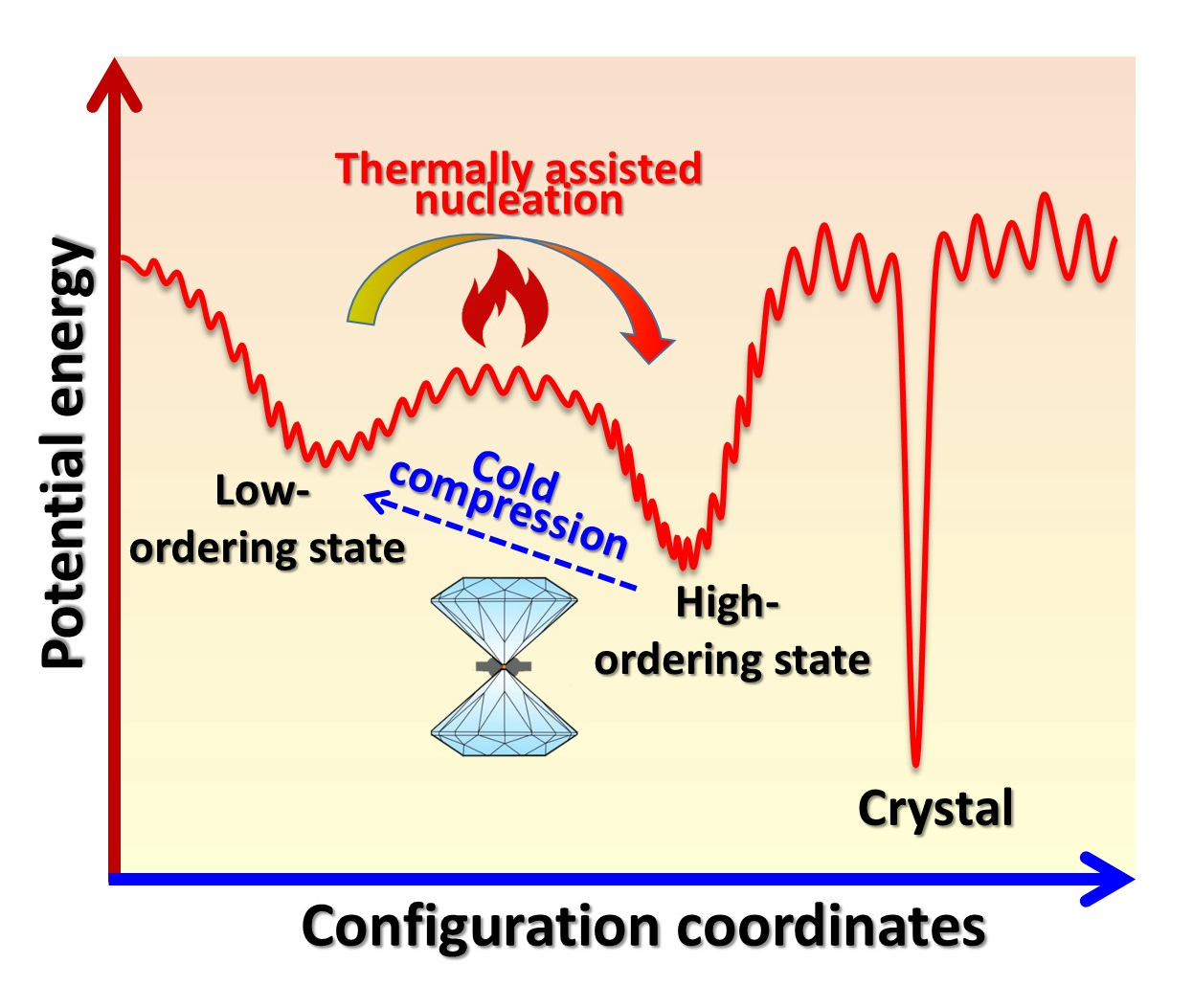Two-way tuning of structural order in metallic glasses – Drs. Hongbo Lou and Qiaoshi Zeng
JANUARY 17, 2020
Metallic glasses are disordered alloys with many properties superior to conventional crystalline metals. Unlike crystalline materials that follow strict atomic-packing rules and imposed symmetry, in principle, metallic glasses have a high degree of freedom to arrange their atoms with almost infinite possibilities in their configuration space. However, in practice, effectively modulating the disordered structures of metallic glasses is rather challenging. A new study from a team of scientists led by Dr. Qiaoshi Zeng from HPSTAR realized a two-way tuning of structures between distinct states in metallic glasses by combining temperature and pressure. Their results are published in the Jan. 16th issue of Nature Communications (DOI: 10.1038/s41467-019-14129-7).
As novel metallic materials with potential applications in broad areas and new model systems for fundamental study of glasses in general, metallic glasses have remained a focus of intense research efforts worldwide. Although the properties of metallic glasses can be significantly altered by conventional synthesis routes or post-fabrication treatments, surprisingly, their structures usually are very much alike and changes are often too subtle to be detected in diffraction and imaging experiments. How much the structures of ‘disordered’ metallic glasses can be tuned and how to modulate their structures in an effective and well-controlled manner remain unresolved issues in materials research.
The team of scientists led by Dr. Qiaoshi Zeng employed multiple in situ high-temperature and high-pressure synchrotron radiation x-ray techniques to carefully monitor the structural evolution of metallic glasses, which demonstrated the two-way tuning of structural order between different states in the metallic glasses are possible and visible.
First, the team studied the temperature effect on metallic glasses. They applied in situ high-temperature high-energy x-ray diffraction (XRD) and small-angle x-ray scattering (SAXS) measurements on the Ce65Al10Co25 metallic glass samples to probe the structural evolution during heating.
They found that when the sample was heated above the glass transition temperature into the first exothermal event, the commonly expected crystallization with sharp Bragg diffraction peaks in XRD did not take place. Instead, the diffraction peaks only show slightly enhanced peak intensity and narrowed peak width. The pair distribution function (PDF) and SAXS data further confirmed the enhanced fluctuation of structure and density at the medium-range order, suggesting a structural ordering transition from the initial relatively low-ordering state (LOS) to a relatively high-ordering state (HOS) on heating prior to its primary crystallization.

“Interestingly, this ordering process is irreversible, i.e., the HOS can be recovered to room temperature with a moderate cooling,” said Dr. Hongbo Lou, the lead author of the work. “This implies that this highly ordered state might be in a solid-state through a reentrant glass transition rather than from one supercooled liquid to another.”
By applying high-pressure to the HOS sample up to 40 GPa using diamond anvil cell (DAC) at room temperature, they found that the thermal-driven HOS was returned to the initial LOS which is called HP-LOS revealed by in situ XRD and SAXS measurements.
“We also found similar structural ordering/disordering transitions in other metallic glasses with different compositions, such as the La65Al10Co25 metallic glass and the Ti20Zr20Hf20Cu20Co20 metallic glasses,” said Dr. Hongbo Lou. “These structural transitions during temperature and pressure treatments demonstrate an effective two-way tuning of the atomic structures in metallic glasses. It could be general in metallic glasses, but difficult to detect it unless you carefully check the structural evolutions using right in situ probes,” explained Dr. Qiaoshi Zeng.
Their further in situ resistance measurements under high-temperature and high-pressure also revealed two-way tuning of properties accompanying the structural changes.
“By combining temperature and pressure, we may be able to tune the structures (ordering/disordering) in metallic glasses to a great extent into many other metastable states that have never been achieved or explored before in the configuration space, which may also lead to the discovery of various metallic glass structures (states) that are inaccessible by traditional routes,” added Dr. Qiaoshi Zeng.
Caption: Two-way tuning of structural order in metallic glasses by temperature and pressure.
金属玻璃是一种非晶态的合金材料,和传统晶态金属材料相比,具有许多优异的性能。由于没有晶态材料中原子排列严格的对称性约束,无序的金属玻璃的原子堆积具有极大的自由度,在理论上具有近乎无限的丰富的构型可能性。但是,实践发现想要有效地调控金属玻璃材料的原子结构相当挑战。北京高压科学研究中心的曾桥石研究员带领的研究团队通过高温结合高压的调控和原位检测,实现了对金属玻璃原子结构序的有效双向调控。他们发现的这种双向调控揭示了金属玻璃结构态的丰富性和自由调控性,将推动我们对金属玻璃结构的理解和应用。相关研究发表于近期的《自然通讯》。
